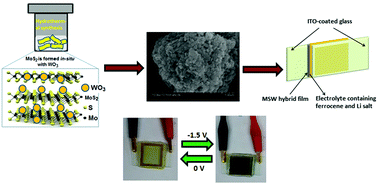Fabrication of MoS2/WO3 nanocomposite films for enhanced electro-chromic performance†
Abstract
A novel MoS2/WO3 nanocomposite (MSW) based electrochromic device (ECD) has been fabricated by a facile cost effective sol–gel spin-coating approach. MoS2 is hybridized with WO3 nanoparticles via an in situ hydrothermal method. The fabrication of the ECD film using a low temperature solution-process is in high demand for flexible applications. The fabricated MSW films exhibited enhanced transmittance variation (ΔT ∼ 75–60%), good colouration efficiency (51.2–39.4 cm2 C−1) and fast switching times compared to pure WO3 films at 700 nm with an applied potential of 0 V to −1.5 V. It is expected that the good electrical conductivity, high specific surface area and unique graphene-like sheet structure of the MoS2 layer will allow facile and effective insertion of Li+ ions at the interface between the film and the electrolyte, hence promoting a higher electron transfer rate, which is crucial for increasing the electrochromic properties of WO3 films. It is expected that the MSW composite film could be a promising material for practical EC applications. In addition, the application of MoS2 may create a new pathway for inorganic hybrid materials as possibly suitable graphene alternatives in EC devices and potential candidates for a flexible transparent conductive electrode (TCE) as well.



 Please wait while we load your content...
Please wait while we load your content...